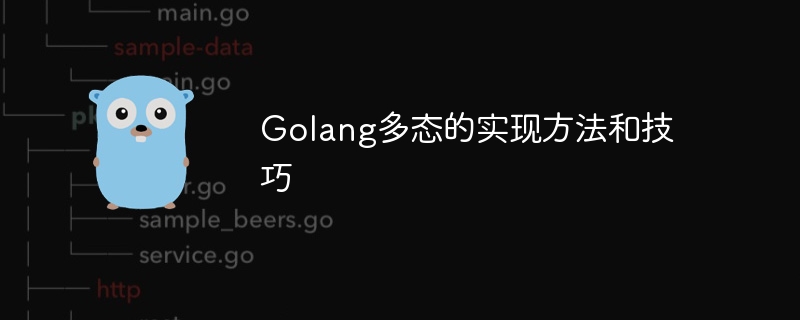Home >Backend Development >Golang >Methods and techniques for implementing Golang polymorphism
Methods and techniques for implementing Golang polymorphism
- WBOYWBOYWBOYWBOYWBOYWBOYWBOYWBOYWBOYWBOYWBOYWBOYWBOriginal
- 2024-01-28 09:11:071076browse

Golang polymorphism implementation methods and techniques
In the Go language, polymorphism is an important concept in realizing object-oriented programming, which allows different types of Objects are used in the same way. By using polymorphism, you can reduce code redundancy and increase code flexibility and scalability. This article will introduce the methods and techniques to implement polymorphism in Golang, and provide specific code examples.
1. Interface Implementation Polymorphism
In Golang, polymorphism can be achieved through interfaces. An interface defines a set of methods. As long as a type implements all methods in the interface, it is considered an implementation type of the interface. By defining interfaces, we can handle different objects in the same way.
The following is a simple example showing how to achieve polymorphism through interfaces:
package main
import "fmt"
type Shape interface {
Area() float64
}
type Rectangle struct {
width float64
height float64
}
type Circle struct {
radius float64
}
func (r Rectangle) Area() float64 {
return r.width * r.height
}
func (c Circle) Area() float64 {
return 3.14 * c.radius * c.radius
}
func main() {
var s1 Shape
r := Rectangle{width: 3, height: 4}
s1 = r
fmt.Println("Rectangle area:", s1.Area())
var s2 Shape
c := Circle{radius: 5}
s2 = c
fmt.Println("Circle area:", s2.Area())
}In the above code, we define a Shape interface with only one method Area. Then we defined two structures, Rectangle and Circle respectively, and implemented the Area method. Finally, in the Main function, we implement polymorphism by assigning Rectangle and Circle types to Shape type variables s1 and s2, and calling their Area methods respectively.
2. Type assertion and type judgment
The Go language also provides a mechanism for type assertion and type judgment, which can determine the actual type of an interface object at runtime and perform corresponding processing. . Type assertion and type judgment are one of the important techniques to achieve polymorphism.
The following is an example that demonstrates how to use type assertions and type judgment to implement polymorphism:
package main
import "fmt"
type Shape interface {
Area() float64
}
type Rectangle struct {
width float64
height float64
}
type Circle struct {
radius float64
}
func (r Rectangle) Area() float64 {
return r.width * r.height
}
func (c Circle) Area() float64 {
return 3.14 * c.radius * c.radius
}
func GetArea(s Shape) float64 {
switch x := s.(type) {
case Rectangle:
return x.Area()
case Circle:
return x.Area()
default:
return 0
}
}
func main() {
r := Rectangle{width: 3, height: 4}
c := Circle{radius: 5}
fmt.Println("Rectangle area:", GetArea(r))
fmt.Println("Circle area:", GetArea(c))
}In the above code, we define a GetArea function that receives a Shape type parameters, and perform type assertion and type judgment on the specific type to call the corresponding Area method. By using type assertions and type judgment, we can dynamically determine specific types at runtime and achieve polymorphism.
Summary:
Through the introduction of this article, we have learned about the methods and techniques to implement polymorphism in Golang. We can achieve polymorphism through interfaces, defining an interface consisting of a set of methods, and letting different types implement these methods. In addition, we can also use the mechanism of type assertion and type judgment to determine the actual type of an interface object at runtime and process it accordingly. These methods and techniques can help us reduce code redundancy and improve code flexibility and scalability. I hope that through the introduction of this article, I can have a deeper understanding of the implementation method of polymorphism in Golang.
The above is the detailed content of Methods and techniques for implementing Golang polymorphism. For more information, please follow other related articles on the PHP Chinese website!

